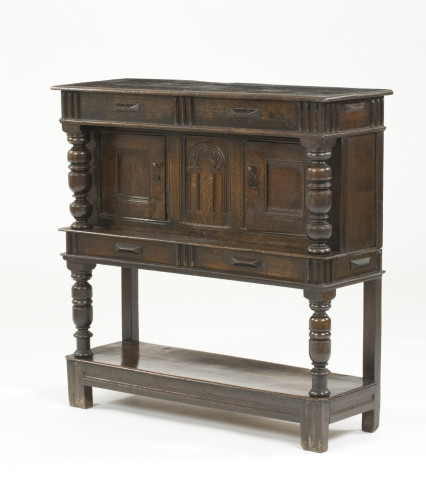30/2008
Collection
Furniture
Brief description
Oak court cupboard in two sections, the upper section with two cupboard doors flanking a central carved panel and two columns supporting an overhanging frieze, made in England c.1630.
Object name
Cupboard
Object number
30/2008
Location
On Display
Production date
c.1630 (manufactured)
Production place
England (manufactured)
Period
Stuart (1603-1714)
Material
oak
Technique
joined
turned
applied
carved
turned
applied
carved
Physical description
Joined oak court cupboard, in three tiers, constructed in two sections. The upper section has a recessed cupboard with two panelled doors flanking a central panel carved with an arch with reeded columns and S-shaped decoration. In front of this are The upper section is flanked by detached turned pillars standing in the middle tier or shelf, which support a frieze. There is a thin board above the frieze acting as the top shelf.
The lower section is open with the same frieze as the upper section and two turned posts at the front of the frame and two plane posts at the back. The lowest section has a planed base with run moulded sides. It rests on a joined frame with block feet.
The colour is a fairly homogenous, dark brown with even patination, although lighter on exposed surfaces and heavier in areas of minimal wear. There are suggestions of paint/ other finishes to the bases of the pillars, the triglyphs (channelled tablet) and on the rail moulding. The top board has a split extending a third of the way along which has been repaired with two dovetail keys. The backboard is much lighter in colour than the rest of the cupboard.
The locks, key-holes and door knobs are all replacements. The bottom board may have been replaced. The bottom shelf has chips to both corners. The front triglyphs are missing from the inside digit on each side and two more have been lost from the left side and one from the right side.
Object was physically marked with its Object number on 08/02/2010. Marked on the back on the top right hand side of the cupboard.
The lower section is open with the same frieze as the upper section and two turned posts at the front of the frame and two plane posts at the back. The lowest section has a planed base with run moulded sides. It rests on a joined frame with block feet.
The colour is a fairly homogenous, dark brown with even patination, although lighter on exposed surfaces and heavier in areas of minimal wear. There are suggestions of paint/ other finishes to the bases of the pillars, the triglyphs (channelled tablet) and on the rail moulding. The top board has a split extending a third of the way along which has been repaired with two dovetail keys. The backboard is much lighter in colour than the rest of the cupboard.
The locks, key-holes and door knobs are all replacements. The bottom board may have been replaced. The bottom shelf has chips to both corners. The front triglyphs are missing from the inside digit on each side and two more have been lost from the left side and one from the right side.
Object was physically marked with its Object number on 08/02/2010. Marked on the back on the top right hand side of the cupboard.
Dimensions
Height: 117cm
Width: 118.4cm
Depth: 41cm
Width: 118.4cm
Depth: 41cm
Website keywords
storage
Label
Label text for 1630 Period Room (Room 1), Geffrye Museum, 2010:
Cupboard
This piece of furniture was known as a ‘court’ or ‘press’ cupboard. It was used to display shiny brass and pewter plates and candlesticks, colourful ceramic plates and, in wealthier households, silver plates and vessels. When the household was dining, the green ‘cupboard cloth’ was replaced with a linen one and the drinks were served from here. Cups were passed to the diners and returned to the court cupboard, rather than being placed on the table. This protected the tablecloth from spillages. The cupboard would also have been used to store things that were frequently used in the room such as table linen.
Oak, inlaid with fruitwood, c1620
Cupboard cloth, replica; wool saye
Label text for the exhibition At Home with the World, Geffrye Museum (20 March 2012- 9 September 2012):
Court cupboard
This item of furniture was made in England, perhaps locally in London, but the decoration on it is influenced by the ancient civilizations of Greece and Rome. Look at the decorative panel between the two cupboard doors. The rounded arch echoes the triumphal arches built hundreds of years before by Roman emperors.
Cupboard
This piece of furniture was known as a ‘court’ or ‘press’ cupboard. It was used to display shiny brass and pewter plates and candlesticks, colourful ceramic plates and, in wealthier households, silver plates and vessels. When the household was dining, the green ‘cupboard cloth’ was replaced with a linen one and the drinks were served from here. Cups were passed to the diners and returned to the court cupboard, rather than being placed on the table. This protected the tablecloth from spillages. The cupboard would also have been used to store things that were frequently used in the room such as table linen.
Oak, inlaid with fruitwood, c1620
Cupboard cloth, replica; wool saye
Label text for the exhibition At Home with the World, Geffrye Museum (20 March 2012- 9 September 2012):
Court cupboard
This item of furniture was made in England, perhaps locally in London, but the decoration on it is influenced by the ancient civilizations of Greece and Rome. Look at the decorative panel between the two cupboard doors. The rounded arch echoes the triumphal arches built hundreds of years before by Roman emperors.






